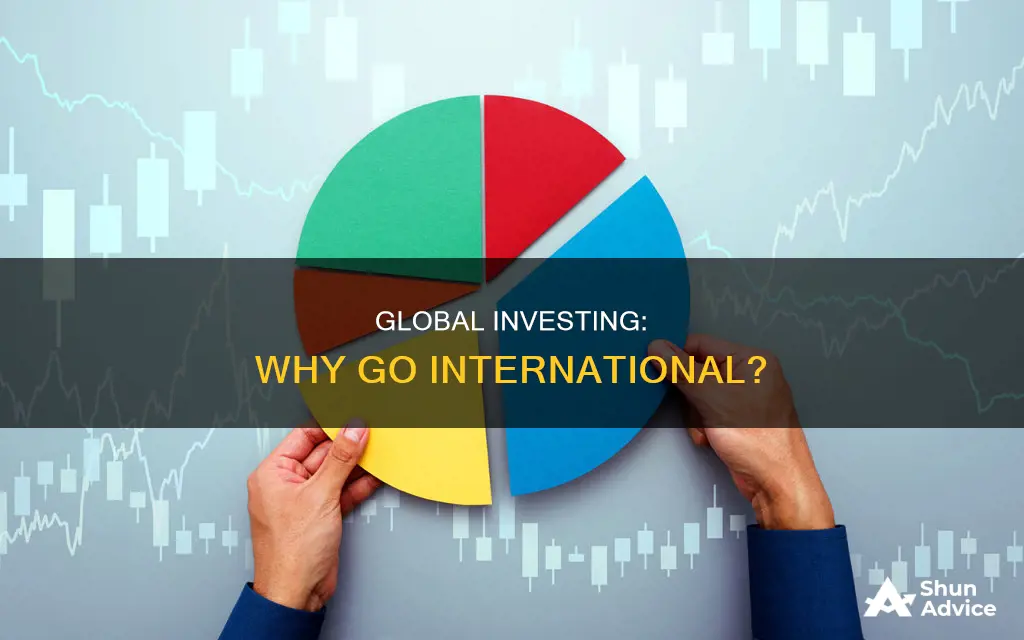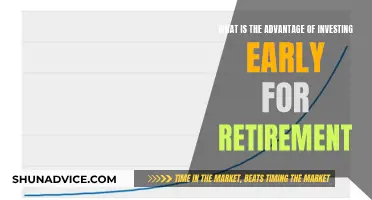
There are several reasons why people choose to invest internationally. Firstly, diversification is a key factor, as investing in international markets allows individuals to spread their investment risk across different countries and industries. This can help to reduce the volatility of their portfolio and protect against downturns in any one market. Secondly, international investing provides exposure to a wider array of economic and market forces, allowing investors to benefit from growth in emerging markets and take advantage of global economic trends. Additionally, investing internationally can provide access to companies that may not be available on domestic exchanges, such as Nestlé, Samsung, and Volkswagen. Finally, international investing can offer the potential for higher returns over the long term, as historically, international stocks have outperformed domestic stocks in certain periods.
| Characteristics | Values |
|---|---|
| Diversification | Exposure to a wider array of economic and market forces across regions and nations |
| Growth | Take advantage of the potential for growth in some foreign economies, particularly in emerging markets |
| Risk reduction | Owning pieces of both international and domestic securities can level out some of the volatility in your portfolio |
| Access to foreign companies | Exposure to companies like Nestle, Samsung, and Volkswagen |
What You'll Learn

Diversification of returns
International investing provides access to emerging and developed markets, allowing investors to take advantage of growth in foreign economies. For example, emerging markets such as China, India, and Brazil have experienced rapid economic growth, presenting opportunities for high returns. However, it is important to note that emerging markets also carry higher risks due to their volatile nature and less advanced infrastructure.
U.S. investors, in particular, can benefit from international diversification as it allows them to spread their investment risk beyond U.S. companies and markets. By investing in international stocks, investors can gain exposure to different economic forces and market cycles, reducing the impact of underperforming domestic investments. This strategy can smooth out returns and enhance overall portfolio performance.
Additionally, international investing provides access to a broader range of investment instruments, including stocks, bonds, mutual funds, and exchange-traded funds (ETFs). These investment options offer varied levels of risk and potential returns, allowing investors to build a more diversified portfolio.
It is worth noting that international investing also carries additional risks, such as currency fluctuations, political and economic instability, and reduced access to information. However, by carefully considering these risks and incorporating international investments into their portfolios, investors can benefit from the diversification of returns and potentially improve their long-term investment outcomes.
Salem's Investment: Town Secrets
You may want to see also

Exposure to a wider array of economic and market forces
US equities are primarily exposed to the economic forces of the US market, whereas international stocks can provide exposure to a broader range of economic and market forces across regions and nations. Different markets and economies often produce returns that vary from the US market, and this diversification of returns can benefit investors over time. By spreading investments across both domestic and international opportunities, investors can position their portfolio to benefit from the best-performing regions at any given time, while also mitigating the impact of underperforming areas.
Additionally, international stocks can provide a hedge against currency risk. While currency risk can impact the returns on international investments, it can also help US consumers by reducing the impact of a depreciating US dollar. A falling dollar can lead to rising import costs and increased prices for domestic companies, ultimately resulting in higher inflation. Having exposure to international stocks can help diversify this risk and protect against the negative consequences of a falling dollar.
Furthermore, investing internationally can provide access to emerging markets with higher growth potential. These markets, such as China, India, or Brazil, tend to have higher volatility, younger populations, and rapid economic growth. Investing in these markets can offer the potential for growth and higher returns, although it also carries greater risk.
Overall, investing internationally provides exposure to a wider array of economic and market forces, offering diversification benefits and the potential for higher returns. By investing in international stocks, investors can gain access to returns from markets and economies that differ from the US, hedge against currency risk, and tap into the growth potential of emerging markets.
Stock Market: Why Don't More People Invest?
You may want to see also

Reduced volatility
International investing can help reduce the volatility of an investment portfolio. Markets outside the US do not always rise and fall at the same time as the domestic market. Therefore, owning both international and domestic securities can level out some of the volatility in a portfolio. This is especially true for investors who are heavily exposed to the economic forces of the US market, such as US equities.
By investing in international stocks, investors can gain exposure to a wider array of economic and market forces across regions and nations. Different markets and economies can produce returns that vary from the US market, and this diversification of returns can benefit investors. In any market environment, spreading investments across domestic and international opportunities can position a portfolio to benefit from the regions that are performing well and help offset areas that are underperforming.
Historically, the US equity market has not always been the top performer. For example, during the period from 1970 to 2022, Hong Kong, Denmark, Sweden, the Netherlands, and Switzerland have all had higher average returns than the US equity market. Despite the smaller size of these economies, this example illustrates the importance of diversification.
According to Modern Portfolio Theory (MPT), a US investor should have about 61% of their portfolio invested in US stocks, with the remainder in non-US stocks. Historical data shows that volatility decreases as non-US stocks are added to a portfolio incrementally. Portfolio risk is minimised when non-US equity represents between 35% and 40% of total equity exposure, reflecting a potential optimal diversification point.
However, it is important to note that investing in international assets also comes with risks. The value of international investments can be impacted by changes in currency exchange rates, political and economic events, and liquidity risks. Navigating different economic and political environments can be complex, and expert insights may be needed to make informed investment decisions.
Oregon's Investment Hotspots
You may want to see also

Growth in emerging markets
Emerging markets are developing countries with volatile, fast-growing economies. They are often contrasted with "established markets" or "advanced economies" like the US, which tend to be wealthier and more stable, but slower-growing.
Emerging markets are a unique investment opportunity because they offer equal parts risk and reward. While there are huge gains awaiting investors who can identify the right emerging market investment at the right time, the risks involved are sometimes understated.
The process of emerging into a developed economy isn't always an upward trajectory. Countries can face political upheaval or natural disasters that can seriously (and suddenly) stymie their economic growth. This can cost enthusiastic investors a lot. For example, Russia has alternated between an emerging market and a developing economy since the 1990s. The aftermath of communism and poor monetary management created a massive debt default, massively devaluing Russia's currency, the ruble.
However, when basic caution is exercised, the rewards of investing in an emerging market can outweigh the risks. Despite their volatility, the most growth and the highest-returning stocks are going to be found in the fastest-growing economies. The secret to adding growth from emerging markets to your portfolio is to limit yourself to reasonable risks. Exchange-traded funds (ETFs) are a great option because you can add an entire country or a combination of countries to your portfolio.
Some of the most prominent examples of emerging markets are the "BRICS" countries: Brazil, Russia, India, China, and South Africa. These countries are good examples of why emerging markets are of interest to investors. While the US economy grew by about 58% between 2012 and 2022, the slowest-growing BRICS economy, South Africa, grew by about 86% over that decade. The other four all had growth rates above 100%.
There are some compelling reasons to make allocations to emerging markets. For starters, they represent about 11% of global market capitalization. Historically, emerging markets have delivered higher average returns, albeit with higher volatility, than those of developed markets. Data also shows that individual emerging markets are relatively uncorrelated across countries, so the risk of investing in all countries as a group (vs. individual countries) is lower.
Where to Invest: Personal Preferences
You may want to see also

Access to foreign companies
Investing internationally allows investors to access foreign companies and markets, which can be beneficial for several reasons. Firstly, it provides exposure to a wider array of economic and market forces across regions and nations. Different markets and economies can produce returns that vary from the US market, and by investing internationally, investors can benefit from the performing regions at any given time. This can also help offset underperformance in other areas.
Another benefit of investing internationally is the potential for growth, particularly in emerging markets. These markets may have less developed economies and infrastructure, but they often experience rapid economic growth. This can be an attractive prospect for investors looking for strong returns.
Additionally, investing internationally can help reduce risk by diversifying an investor's portfolio. By investing in both domestic and international securities, investors can reduce the volatility of their portfolio. Markets outside the US may not always rise and fall simultaneously with the domestic market, so owning a mix of international and domestic securities can spread out the risk.
It is worth noting that investing internationally also comes with certain challenges and risks. These include access to different information, higher costs, currency exchange rate fluctuations, and different levels of liquidity in foreign markets. However, for many investors, the benefits of accessing foreign companies and markets through international investing outweigh these potential drawbacks.
Toxic People: Invest Time Wisely
You may want to see also
Frequently asked questions
International investing can help spread your investment risk among foreign companies and markets, in addition to US companies and markets.
International investing can expose you to a wider array of economic and market forces across regions and nations. Different markets and economies can and often do produce returns that vary from the US market.
There are special risks of international investing, including access to different information, costs, working with a broker or investment advisor, changes in currency exchange rates and controls, changes in market value, political, economic and social events, different levels of liquidity, legal remedies, and different market operations.
There are several ways to invest internationally, including ETFs and mutual funds, American depository receipts, foreign ordinaries, and direct foreign investments.







